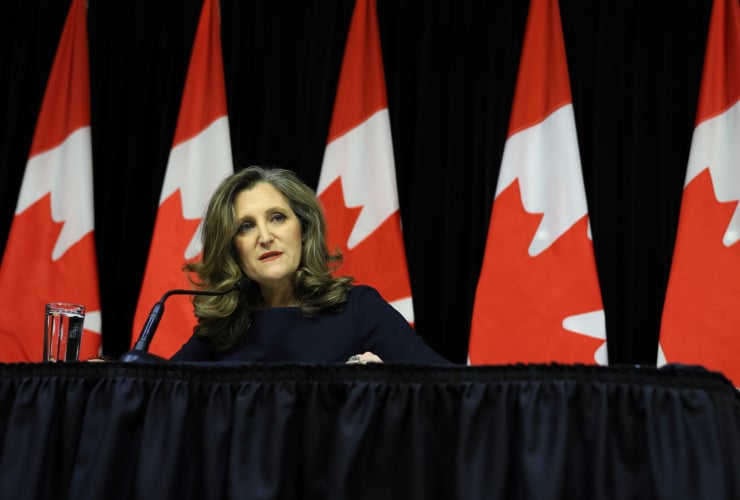Flood insurance is becoming harder to get in many parts of Canada — especially in Quebec.
Currently, insurance companies won’t cover up to 10 per cent of homes for flooding in Canada. And that number is likely to grow as climate change drives more frequent severe weather events, putting more homes at risk from overland flooding.
Currently, there is no comprehensive map of flood risk in Canada. Rob de Pruis, a spokesperson for the Insurance Bureau of Canada (IBC), said a report by Public Safety Canada is “close and a good indicator, but it's not exhaustive.”
“We’re working with the federal government to get comprehensive flood mapping,” de Pruis said. “But it's safe to say that every province and territory has some type of flood risk somewhere in the province.”
According to the report, Quebec has the highest number of properties ineligible for flood insurance, followed by Ontario and British Columbia.
Quebec was found to have the highest number of homes in the top 10 per cent risk of flooding. Mike Duggan, a Gatineau city councillor for Pointe-Gatineau, said about 200 residences in his ward are threatened by flooding and are not eligible for flood insurance.
“I'm hearing of cases where people might not be covered just by virtue of being in a flood zone, which I find kind of alarming,” said Duggan. “In a sense, the market is no longer supplying those services which allow homeownership [in these zones].”
Without insurance, residents are unable to repair their home if it is damaged or get mortgages for homes in high-risk areas. Most lenders require home insurance to protect the mortgage.
In 2017, record rainfall caused rivers to swell, flooding parts of Quebec. According to the IBC’s Quebec branch, torrential rains caused flood damage in 293 municipalities and 15 administrative regions. The province saw similar floods in 2019 and 2023.
Duggan said after residents in his ward received insurance payouts for repairs following the 2017 floods, many insurers stopped covering them for overland flooding. Across the river in Ontario, some residents also lost flood insurance.
Phil Cottrell lives in La Passe, a community about 100 kilometres northeast of Ottawa. Since moving in 2003, Cottrell said the spring thaw has caused the Ottawa River to swell each year. But in 2017, Cottrell said “the river rose alarmingly and flooded out a lot of cottages and properties around here.”
“It was called a 100-year flood, so after 2017, we thought, ‘That's great, we won't get flooded out again,’” he said. “Lo and behold, in 2019, we got an even worse one.”
In late April 2019, the Ottawa River rose again. The resulting flood damaged several houses and submerged roads in water. Cottrell and his wife were stuck at home and so were several neighbours.
“If I went out to the end of my driveway and looked to the left, it was a lake,” he said. “The only way in was with the military in their big [light armoured vehicles], or by boat.”
Water started pouring into the Cottrells’ basement. For about 10 days, he and his wife took five-hour shifts to pump water out of their home, using a wet vac to move water into a sump well.
“That was not much fun,” he said. “It was very traumatic and a lot of people were extremely stressed.”
The flooding subsided by late May that year, without doing much damage to his home. At the time, Cottrell was able to insure his home for overland flooding. But when it came time to renew their insurance, the insurance company would no longer provide coverage.
“They really weren't offering it to anybody around here,” he said. “We pressed them, and they came up with a quote for $6,000 [annually], which I think the guy just made off the top of his head because he didn't really want to insure us.”
Cottrell said they switched companies and were able to cover their home for flooding at a more reasonable rate.
Others have to rely on the province for help. When flooding damages homes without overland flood coverage, many provinces will offer financial assistance to help residents repair their homes or relocate.
In Ontario, the provincial government offers up to $250,000 to people who don’t have sufficient insurance to cover damage from climate disasters. Under a similar program, British Columbia offers up to $400,000 per claim.
But in Quebec, there’s a limit placed on provincial assistance. The provincial government will offer residents about $400,000 if their home has been damaged in a flood, but in 2019, it announced a “lifetime limit” on how much aid a single person can receive.
“The Quebec government offers you a choice,” said Mathieu Boudreault, a climate change and insurance researcher at the Université du Québec à Montréal. “You repair and you stay … or you don't repair and you relocate, and either way, you forgo any financial assistance for the future.”
Boudreault said once residents reach that lifetime limit, if their home is damaged by flooding, they’re “out of luck.”
Many residents choose to leave high-risk zones. In an email to Canada’s National Observer, a spokesperson for the City of Laval, Philippe Déry, said the city has 420 residential buildings in recurrent flood zones. Déry said the floods are pushing residents to vacate homes near the Rivière des Mille îles and Prairies River.
“Relocating residences at very high risk would give the river back its breathing space,” he said. “In less at-risk areas, the deployment of public flood defences and funding programs for resilient residential renovation would enable existing neighbourhoods to be preserved.”
Back in Gatineau, Duggan said the number of properties decreases with every flooding event as some homes are damaged beyond repair. Still, many residents don’t want to relocate.
“There are people who are going to stay in their houses no matter what. If the government tries to remove them, they're going to fight it,” Duggan said. “Some are intergenerational houses or the home [residents] raised their kids in… They're gonna retire in this home, so they invest in a new foundation, get it raised and stay.”






Comments